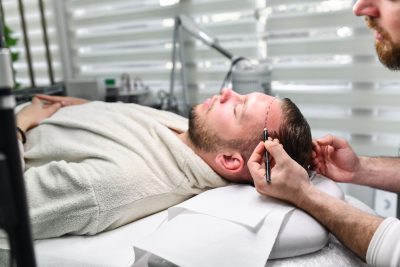 What is Hair Transplantation?
What is Hair Transplantation?
Hair follicles may lose their active life for various reasons, resulting in hair loss. In this case, hair transplantation is a tissue transplantation applied for individuals who have experienced regional or homogeneous hair loss. Success in hair transplantation is inevitable when combined with a customized application procedure for different cases and post-operative support treatment.
What are Hair Loss Treatments?
First of all, the factors that cause hair loss should be determined and a preventive and curative treatment plan should be drawn accordingly. Within this plan, vitamin supplements that nourish hair follicles, PRP, mesotherapy and stem cell therapy, hair laser application can be performed. Hair loss problem can be solved with a problem-oriented treatment.
What are the Causes of Hair Loss?
The primary type of hair loss that causes permanent baldness in men and women is known as Androgenetic alopecia (Male pattern hair loss). Androgenetic alopecia is carried through the genetic code and periodically triggers various hair loss episodes between the ages of 20-35. It is known that it is possible to slow down hair loss with hair treatments.
In addition, hair loss can be caused by various environmental factors. Fungal infections, chemotherapy, vitamin deficiencies, radiation and immune system diseases that affect the health of the scalp can also be among the causes of hair loss.
Who Can Have Hair Transplantation?
Hair transplantation is an operation that can be applied for every individual, male and female, from the age of 18, who does not have a health problem that prevents the operation. The necessity and applicability of this operation is determined only after a consultation with a dermatologist and hair transplant specialist. The decisive criterion here is that the operation result is successful at the predicted rate.
What are Hair Transplant Techniques?
The two most preferred methods for hair transplantation in today's technology are known as FUE and DHI. In the FUE technique, hair follicles taken one by one from the donor area (the nape area between the two ears) with the help of a micromotor are placed one by one in the channels opened in the transplantation area. It is not expected to leave any scar on the nape. When an empty and large area needs to be transplanted, the appropriate technique is the FUE technique.
The DHI technique, on the other hand, is a direct transplantation technique developed in a relatively narrow area, especially in case of damage to the existing hair follicles in the area. In the DHI technique, the roots taken from the donor area with the help of a micromotor are placed in the application area with a medical pen (choi pen) in one move. There are no steps such as opening the canals and then placing the roots in the canals, the roots are transferred directly under the skin by means of medical pens. No scarring on the neck is expected for this technique.
The technique to be applied for hair transplantation is determined by the current hair condition of our patients. Techniques are not superior to each other. You can contact our health consultants to learn the right technique for you.
How Does the Hair Transplant Process Proceed?
On the day of the operation, after the drawings are made in the transplantation area during the examination, a partial or complete haircut is performed according to the operation plan. Local anesthesia is then applied to the scalp, which is numbed with pressurized painless anesthesia. The operation is expected to last approximately 6-8 hours.
The day after the operation, the bandage in the donor area is removed and the patient is first checked and dressed. As of the second day, the patient should perform a lotion wash in the transplant and donor area.
Our recommendation for the first wash is to be performed by our specialized nurses in our hospital. It is recommended to perform hair washing periodically for ten days. On the tenth wash, the scabs on the scalp will be cleaned with a massaging wash, and no trace of the operation is expected afterwards. Our patient follow-up unit monitors the processes of our patients who have undergone this operation online.
What is the Average Hair Transplant Operation Price?
Our hair transplant operations cost 2500-3000 euros on average.
Who Can Have Hair Transplantation?
Hair transplantation is an operation that can be applied for every individual, male and female, from the age of 18, without any health problems that prevent the operation. The necessity and applicability of this operation is determined only after a consultation with a dermatologist and hair transplant specialist. The decisive criterion here is that the operation result is successful at the predicted rate.
How Many Hours Does Hair Transplant Operation Take?
Our operations take 6-8 hours on average.
Which part of the body are hair follicles taken from?
The most fertile area where hair follicles can be harvested is the nape of the neck behind both ears. This area is genetically programmed not to shed. It has the same characteristics as your hair in the frontal areas. From a scientific point of view, it is also possible to transplant with follicles taken from the leg, chin or chest area, but the structure of the hair in these areas may not have the same characteristics as the structure of your hair, which may cause unnatural results or decrease the success of the transplant.
Can Someone Else's Hair Root Be Transplanted in Hair Transplantation?
No. The body does not accept hair taken from someone else. Hair transplantation cannot be performed with grafts taken from a different body because the transplanted hair will not hold.
Can I Play Sports After Hair Transplantation?
You should avoid sports and physically demanding activities for at least two weeks after the hair transplant operation. After 2 weeks, simple walking and daily exercises can be started.
Is Hair Transplantation a Risky Procedure?
Hair transplantation is a superficial surgical operation. It must be performed in a hospital environment and under the supervision of a doctor. It is an application open to various skin infections due to direct contact with the skin. Therefore, choosing the right hospital is very important.
In particular, factors such as the experience of the team, the use of sterile devices, the necessary tests before transplantation in terms of patient health, and the necessary support after transplantation should be taken into consideration. Drawing the hairline correctly and transplanting in the right direction are also among the most important factors to be considered.
Is There Pain During Hair Transplantation?
Since the Comfort-In needle-free and painless anesthesia method is used in the hair transplant operation, no pain or ache is felt.
Do we charge per root (graft)?
We perform our operations with a maximum graft target. The pricing of the operation techniques differ from each other, but our patients who have 4000 roots transplanted with the same technique and our patients who have 6000 roots transplanted do not pay differently from each other.
Is There Redness After Hair Transplantation?
There may be redness during the wound healing process. In non-sensitive skin, this redness is expected to disappear within 10 days. However, in sensitive skin, this redness may take longer.
How will I stay when I come to Istanbul for hair transplantation? Do you have a hotel?
We welcome our patients arriving in Istanbul at the airport with our translator and VIP vehicle and then provide them with accommodation in a 5-star hotel during their stay in Istanbul. We are very careful to provide our guests with all the necessary comfort during the operation process.
When Does Transplanted Hair Grow?
The first hair grows approximately three months after the hair transplant operation. It takes about 1 year for all the follicles to produce hair.
Things to Consider After Hair Transplantation
- Heavy Physical Exercises: Intense exercise and activities that cause sweating should be avoided in the first week. Light exercises can be continued after a few days.
- Avoid Immersing Your Scalp in Water: Avoid immersing your scalp in baths or pools as this can expose the grafts to potential contamination.
- Limit Styling Products: Avoid using styling or chemical sprays that can irritate treated areas.
- Minimize Sun Exposure: Excessive sun exposure can damage both your scalp and newly transplanted hair follicles. Your scalp is especially sensitive to UV rays after the procedure.
- Avoid Alcohol and Tobacco: These substances can affect blood circulation in the scalp, which is vital for healing.
- Hair Dye: Chemicals in hair dyes can damage the scalp; avoid coloring your hair during the healing phase.
- Hands: Resist the urge to touch or rub your head as this can disrupt the grafts.
- Sleep Position: Keep your head elevated while sleeping for the first 2-3 days.
- Be Careful About Hats: Although there is no harm in wearing loose hats after the first two days, be careful not to dislodge the grafts.
Surgeon
Dermatologic Hair Transplant Specialist and Team
Duration of Surgery
5 - 6 Hours
Anesthesia
Local Anesthesia
Hospital Accommodation
No Accommodation
Recovery Time
2 Days
Hospital and Airport Transfer
Price Includes
Hotel Accommodation
3 Nights 4 Days (Included in Price)
Dressing
The Day After the Operation
Washing
Day 2 After Operation








